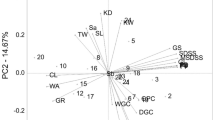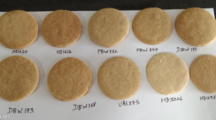Abstract
Dry white Chinese noodle (DWCN) is widely consumed in China, and genetic improvement of DWCN quality has become a major objective for Chinese wheat breeding programs. One hundred and four bread wheat cultivars and advanced lines, including 88from major Chinese wheat-producing areas, were sown in two locations for two years. Their DWCN quality, as evaluated by trained panelists, was studied to determine the relationship between wheat quality parameters and DWCN quality attributes. In general, the cultivars and advanced lines used in this study are characterized with acceptable protein content, but accompanied with weak-medium gluten strength and poor extensibility, and substantial variation is observed for all grain and DWCN quality characters. On average, Australia and USA wheat performed better DWCN quality than Chinese wheats. Simple correlation analysis indicated that both grain hardness and Farinograph water absorption were negatively associated with cooked DWCN color, appearance, smoothness, and taste. Flour whiteness and RVA peak viscosity was positively associated with all DWCN parameters, and their correlation coefficients (r) with DWCN score are 0.34 and 0.41, respectively. Their positive contributions to DWCN quality were mostly through improved color, appearance, smoothness, and taste. Farinograph mixing tolerance index (MTI) and softening were negatively associated with all DWCN quality parameters, and their correlation coefficients with DWCN score are –0.50 and–0.54, respectively. Further analysis indicated that association between protein content, Zeleny sedimentation value, Farinograph stability, and Extensograph extensibility, and DWCN score fit quadratic regression model significantly, with R2 0.12, 0.32, 0.22, and 0.20, respectively. The associations between Zeleny sedimentation value and DWCN's appearance and taste also fit quadratic regression model significantly. This suggests that to certain extent, increased protein content and gluten quality contribute positively to DWCN quality, mostly by improving palatability, elasticity, and stickiness. High flour whiteness, medium protein content, medium to strong gluten strength and good extensibility, and high starch peak viscosity are desirable for DWCN quality. Genetic improvement for flour whiteness, protein quality and starch paste viscosity would increase the DWCN quality of Chinese bread wheat cultivars.
Similar content being viewed by others
References
AACC, 1983. Approved Methods of the American Association of Cereal Chemists. 7th edition. St. Paul, MN. USA.
Azudin, M.N., 1998. Screening of Australian wheat for the production of instant noodles. In: A.B. Blakeney & L. O'Brien (eds.), Pacific People and Their Food, pp. 123-142. American Association of Cereal Chemists. St. Paul, MN, USA.
Baik, B.K., Z. Czuchajowska & Y. Pomeranz, 1994. Comparison of polyphenol oxidase activities in wheats and flours from Australia and U.S. Cultivars. J Cereal Sci 19: 291-296.
Baik, B.K., Z. Czuchajowska & Y. Pomeranz, 1995. Discoloration of dough for oriental noodles. Cereal Chem 72: 198-205.
Chinese Ministry of Commerce, 1993. Noodle Flour. SB/T10137-93.
Chinese National Standard, 1989. Whiteness Tester. ZBN133012-89.
Crosbie, G.B., 1991. The relationship between starch swelling properties, paste viscosity and boiled noodle quality in wheat flours. J Cereal Sci 13: 145-150.
Crosbie, G.B., W.J. Lambe, H. Tsutsui & R.F. Gilmour, 1992. Further evaluation of the flour swelling volume test for identifying wheats potentially suitable for Japanese noodles. J Cereal Sci 15: 271-280.
He, Z.H., 1999. Wheat breeding and quality requirements in China. In: Proc. 9th Assembly of the Wheat Breeding Society of Australia, pp. 23-28.
He, Z.H., R.J. Peña & S. Rajaram, 1998. Assessment of the bread making quality of Chinese wheats. In: L.Z. Wang & J.R. Dai (eds.), Proc. China Nat Crop Breed Symp. China Agritech Publisher, Beijing, China, pp. 157-162.
He, Z.H., Z.J. Lin, L.J. Wang, Z.M. Xiao, F.S. Wan & Q.S. Zhuang, 2002. Classification on Chinese wheat regions based on quality. Scientia Agricultura Sinica 35(4): 359-364.
Huang, D.Y. & Z.J. Lin, 1990. Association between wheat quality and noodle quality. Acta Agriculturae Boreali-Sinica 5: 40-45.
Huang, S., 1996. A look at noodles in China. Cereal Food World 41: 199-204.
Huang, S.D. & W.R. Morrison, 1988. Aspects of proteins in Chinese and British common (hexaploid) wheats related to quality of white and yellow Chinese noodles. J Cereal Sci 8: 177-187.
Jin, Y.J., K.J. Quail, L. O'Brien & F. Bekes, 2000. Effects of nitrogen level and genetic variation on noodle texture. P111, Abstract of 11th Cereal and Bread Congress and the 50th Australian Cereal Chemistry Conf.
Lang, C.E., S.P. Lanning, G.R. Carlson, G.D. Kushnak, P.L. Bruckner & L.E. Talbert, 1998. Relationship between baking and noodle quality in hard red spring wheat. Crop Sci 38: 823-827.
McCormick, K.M., J.F. Panozzo & S.H. Hong, 1991. A swelling power test for selecting potential noodle quality wheats. Aust J Agric Res 42: 317-323.
Morris, C.F., 1998. Evaluating the end-use quality of wheat breeding lines for suitability in Asia noodles. In: A.B. Blakeney & L. O'Brien (eds.), Pacific People and Their Food. American Association of Cereal Chemists, pp. 91-100. St. Paul, MN, USA.
Moss, R., P.J. Gore & I.C. Murray, 1987. The influence of ingredients and processing variables on the quality andmicrostructure of Hokien, Cantonese and instant noodles. Food Microstr 9: 63-74.
Nagao, S., S. Ishibashi, S. Imai, T. Sato, Y. Kanabe, Y. Kaneko & H. Otusubo, 1977. Quality characteristics of soft wheats and their utilization in Japan. II. Evaluation of wheats from the United States, Australia, France & Japan. Cereal Chem 54: 198-204.
Oh, N.H., P.A. Seib & K.F. Finney, 1986. Noodles. V. Determination of optimum water absorption of flour to prepare oriental noodles. Cereal Chem 63: 93-96.
Oh, N.H., P.A. Seib, A.B. Ward & C.W. Deyoe, 1985. Noodles. Influence of flour protein, extraction rate, particle size & starch damage on the quality characteristics. Cereal Chem 62: 441-446.
Schuler, S.F., R.K. Bacon, P.L. Finney & E.E. Gbur, 1995. Relationship of test weight and kernel properties of milling and baking quality in soft red winter wheat. Crop Sci 35: 949-953.
Toyokawa, H., G.L. Rubenthaler, J.R. Powers & E.G. Schanus, 1989a. Japanese noodle qualities. I. Flour components. Cereal Chem 66: 382-386.
Toyokawa, H., G.L. Rubenthaler, J.R. Powers. & E.G. Schanus, 1989b. Japanese noodle qualities. II. Starch components. Cereal Chem 66: 387-391.
Wang, R., S.B. Li, G.R. Wang & C.P. Zhao, 1995. Association between wheat quality and quality of bread, noodle & steamed bread. Agron Abroad-Wheat Sci 3: 35-37.
Yao, D.N., 1999. Study on Inheritance of Starch Properties, Waxy Protein and Relation to Quality in Common Wheat. PhD thesis, China Agricultural University.
Yun, S.H., K. Quail & R. Moss, 1996. Physicochemical properties of Australia wheat flours for white salted noodles. J Cereal Sci 23: 181-189.
Zhao, Z.D., J.J. Liu, J.Y. Dong, L. Zhang & Q. Li, 1998. Association between TOM and cooking quality of Chinese noodle. Acta Agronomica Sinica 24: 738-742.
Zhang, Y., Z.H. He, G.Y. Zhou & D.S. Wang, 1999. Genotype and environment effects on major quality characters of winter-sown Chinese wheats. J Chin Cereals & Oils Assoc 14: 1-5.
Author information
Authors and Affiliations
Rights and permissions
About this article
Cite this article
Liu, J., He, Z., Zhao, Z. et al. Wheat quality traits and quality parameters of cooked dry white Chinese noodles. Euphytica 131, 147–154 (2003). https://doi.org/10.1023/A:1023972032592
Issue Date:
DOI: https://doi.org/10.1023/A:1023972032592




